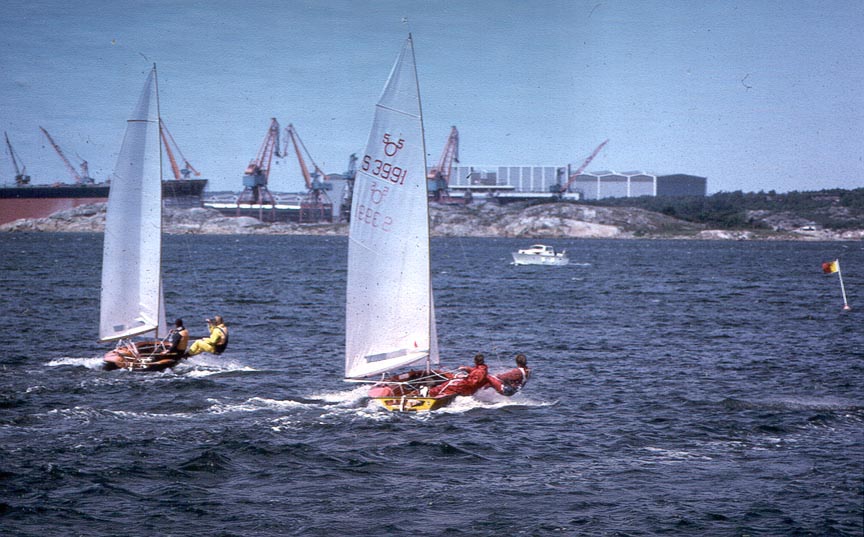Christer Båth demonstrating his Loop

One of the advantages with transom sheeting fitted with a loop is that the helmsman much quicker can react on sudden wind gust, thus taking advantage of the extra power at hand.
The Main advantage with transom sheeting fitted with a loop is that the helmsman much more quickly can react on sudden wind gusts, thus keeping the dinghy in perfect balance as well as optimizing the forward power in the main sail.
As you can see in this picture from a very gusty day the crews of these two 505s have just been hit by the strong gust they were both sailing towards (it was clearly visable on the surface of the water and both helmsmen bore off to reach it ASAP).
As the gust hits the 505s, the forward hands start to move out on the wire, while the helmsmen begin to sheet in the main sail. Normally, one would expect that the helmsman in a strong gust such as this would be forced to release his sheet to keep the dinghy in balance. In this case however, both helmsmen have started to luff to the course they need to be able to reach the weather mark some 200 metres away and slightly to windward, and in doing so they need to correct the angle of the main sail, thus sheeting in.
Christer Bath with brother Pelle on the wire to windward quickly hauls the sheet in to take advantage of the sudden puff. The helmsman in the other 505 however, has with his centre sheeting little chance of doing the same as quickly (no ball bearing main sheet tracks in those days!) and so the dinghy begins to heel to windward.
Transom sheeting - effortless sail control
With a loop for the transom block as on Kalabalik here, the
block is in level with the boom and so Christer doesn´t have to sheet it down (heavy!),
merely in (easy and quick!).
While pulling the main sheet in several meters, Christer clams it with his tiller
extension hand every time he takes a new grip. By simultaneously moving his clamming
tiller extention hand fore and aft without affecting the steering and in conjunction with
his sheeting hand, Christer speeds the sheeting up even further!
It must be mentioned that in order to be able to get the full advantage of transom
sheeting you must have a tight kicking strap.
Superior boat handling
Of all the 505 helmsman this webmaster has been fortunate
enough to sail with through the years (1963-1990), no one has come close to the smooth
boat handling of brother Christer, which in my opinion partly is due to his refined
transom sheeting technique.
In consequence very few 505 sailors in the world, if any, could match Christer´s boat
speed in trapezing conditions (Force 3 and upwards) in the late sixties/early seventies.
Ironically enough, the only international championship Christer and Pelle ever won in the 505 was in light fluky wind conditions (European´s -71), which seemed to be the dominant weather type for most of the championships held during this period.
Advantage in big waves
Another thing with transom sheeting that is worth mentioning is that the interior of the 505 becomes much more open, which enables the crew to move back and forth more easily on a run in big waves.
Today very few 505 sailors seem to be favouring transom
sheeting and the webmaster therefore presumes that you guys must have come up with
something better?
Or is the evolution in 505 sailing only going around in circles, in which case we most
certainly will see transom sheeted 505s again?
Ps. Ali Meller (505s 7200 & 8263) mails the following
comment:
"A number, perhaps the majority, of North American 505 use transom bridles. While we
still pull somewhat down on the mainsheet, unlike your system where you only pull in, we
do eliminate most of the downward component and make it easier to adjust the mainsheet in
puffy conditions. Every 505 I have owned (since my first in 1978) has had a transom bridle
mainsheet."
The webmaster apologizes for his ignorance.
"Lift your eyes and you will see no limits" - old japanese saying